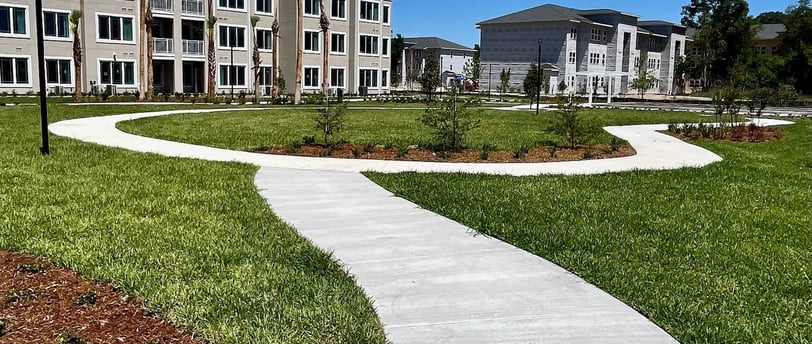CALL US TODAY! → (321) 202-7780
The Importance of Concrete Sidewalks: Enhancing Safety and Aesthetics
Safe, smooth, and built to last. We break down what goes into a high-quality sidewalk. Ideal for homes, businesses, and communities.
4/6/20254 min read


The Value of Professionally Built Sidewalks
Concrete sidewalks offer numerous advantages that extend beyond mere functionality. Their importance is particularly pronounced in settings ranging from residential neighborhoods to bustling commercial areas. A professionally constructed sidewalk serves as a crucial element in ensuring the safety and accessibility of pedestrians, thereby enhancing the overall infrastructure of a community.
One of the primary benefits of concrete sidewalks lies in their structural integrity. Unlike other materials that may deteriorate or become uneven over time, concrete provides a durable and sturdy surface. This longevity not only reduces the frequency of repairs but also minimizes the long-term costs associated with sidewalk maintenance. A well-built concrete sidewalk can withstand various weather conditions, ensuring that pedestrians have a reliable pathway no matter the season.
Moreover, the improved safety that comes from professionally constructed sidewalks cannot be overstated. Cracks, uneven surfaces, or poorly constructed walkways can pose significant hazards to pedestrians, especially for children, the elderly, and individuals with mobility challenges. A smooth, well-maintained concrete sidewalk enhances navigability and decreases the risks of slips, trips, and falls, promoting a safer environment for all users.
In addition to safety, aesthetics play a vital role in the value of concrete sidewalks. A thoughtfully designed sidewalk complements the landscaping and architectural features of surrounding properties. With various finishes and colors available, sidewalks can enhance the visual appeal of a neighborhood or commercial district. Therefore, investing in high-quality workmanship leads to functional and aesthetically pleasing outcomes, ultimately contributing to property value and community pride.
In conclusion, professionally built sidewalks are a fundamental component of urban infrastructure that deliver multifaceted benefits. From enhanced safety to improved aesthetics, the investment in quality concrete sidewalks yields significant returns for both residential and commercial properties.
Installation Techniques and Best Practices
Installing a concrete sidewalk requires careful planning and execution to ensure durability and safety. One of the primary considerations in the installation process is proper grading for drainage. Adequate drainage is critical, as standing water can damage the sidewalk over time and become a safety hazard. Ideally, the sidewalk should be sloped away from structures, allowing water to flow freely to designated drainage areas. A slope of about 1% to 2% is often recommended to facilitate effective drainage without compromising the sidewalk's usability.
Another essential aspect is material selection. The concrete mix should be suited for the expected foot traffic and weather conditions in the installation area. For instance, using high-quality aggregates and additives can enhance water resistance and durability, reducing the risk of cracking due to freeze-thaw cycles or heavy loads. Additionally, choosing the right width and thickness for the sidewalk is vital for its structural integrity. Generally, a minimum thickness of 4 inches is advised for residential sidewalks, while commercial pathways may require thicker slabs to accommodate higher traffic.
Creating a level and sturdy foundation is also critical during the installation of concrete sidewalks. The site should be cleared of any vegetation, roots, or debris that may affect the concrete's performance. After excavation, a compact subbase of gravel or crushed stone should be laid to provide stability and support. Installing formwork to shape the sidewalk is crucial, as it holds the concrete in place until it sets. Careful attention to these installation techniques will not only enhance the sidewalk's safety but also its overall aesthetic appeal, ensuring it remains an attractive addition to any outdoor space.
ADA Compliance and Accessibility Considerations
The Americans with Disabilities Act (ADA) establishes crucial standards that ensure accessibility for individuals with disabilities, fundamentally shaping the design of sidewalks. Compliance with ADA regulations is not merely a legal obligation; it is a vital aspect of fostering an inclusive community that accommodates all residents and visitors. Sidewalks must be designed with specific features that enhance accessibility, including appropriate width, slope, and specific indicators for tactile feedback.
One primary requirement of ADA compliance is the width of the sidewalks. To provide adequate space for individuals using wheelchairs, strollers, or mobility aids, sidewalks should typically have a minimum width of 36 inches. This allows for safe passage and ensures that users can navigate without obstruction. Additionally, sidewalks must include proper slopes, specifically a maximum ratio of 1:20, to guarantee that all users can traverse them without difficulty, even during inclement weather or on uneven surfaces.
Another critical feature involves tactile indicators, which are essential for individuals with visual impairments. These indicators help alert users to potential hazards, such as intersections or changes in surface texture, and guide them along the path. By integrating such elements, municipalities and developers can significantly enhance the safety and usability of urban environments.
Furthermore, creating sidewalks that adhere to ADA standards promotes inclusivity, allowing everyone—regardless of their physical ability—to participate fully in community life. Accessible walkways encourage pedestrian traffic and foster a sense of belonging for all citizens, ultimately enhancing the local environment both aesthetically and functionally. Prioritizing ADA compliance is a proactive approach to ensure that public infrastructure meets the diverse needs of the community.
Finishing Options for Aesthetic Appeal
Concrete sidewalks can be transformed into visually appealing surfaces through various finishing options, which not only enhance safety but also add character to both residential and commercial properties. One popular choice is stamped concrete, a technique that mimics the appearance of natural stone, brick, or even wood. By using molds to create patterns, homeowners and business owners can achieve a high-end look without the associated costs of those materials. Stamped finishes come in a variety of designs and textures, allowing for customization that can suit any architectural style.
Another effective method for enhancing the aesthetic appeal of concrete sidewalks is through the use of coloring techniques. Integral color, where pigments are mixed into the concrete before pouring, provides an even base color that can add warmth or vibrancy to the walkway. Alternatively, surface-applied stains can create a dynamic, variegated look, further enhancing the visual depth of the concrete. These color treatments not only beautify the sidewalk but can also help to camouflage unsightly stains and imperfections, maintaining a pristine appearance for longer periods.
Moreover, the application of protective sealers is crucial in sustaining the sidewalk’s aesthetics over time. Sealers act as a barrier against moisture, UV rays, and chemical spills, minimizing potential damage and fading. Regular maintenance through resealing, typically every few years, helps preserve both the functionality and beauty of the sidewalk. Cleaning the surface with appropriate solutions will also prevent dirt and grime accumulation, thus ensuring that the vibrant colors and textures remain prominent.
In summary, through careful selection of finishing options like stamped designs and coloring techniques, alongside regular maintenance practices, concrete sidewalks can significantly enhance the aesthetics of properties while ensuring longevity and durability.
FOLLOW US ON SOCIAL MEDIA
SUBSCRIBE TO OUR NEWSLETTER
CALL:
HOURS:
Mon-Sat
7:00am-5:00pm
COPYRIGHT © 2025 RAMOS ELITE CONSTRUCTION CORP


